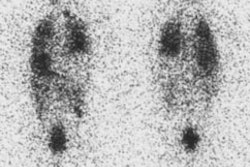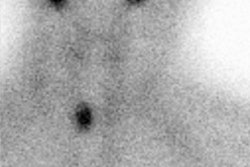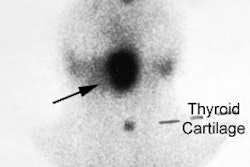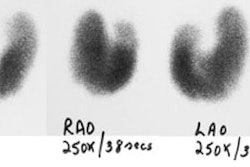J Nucl Med 1998 Sep;39(9):1546-50
Influence of scanning doses of iodine-131 on
subsequent first ablative treatment outcome in patients operated on for
differentiated thyroid carcinoma.
Muratet JP, Daver A, Minier JF, Larra F.
The therapeutic outcome after (131)I first ablative treatment in patients
operated on for nonmedullary differentiated thyroid carcinoma was compared after
both the currently used scanning dose of 111 MBq (131)I and a scanning dose of
37 MBq (131)I. METHODS: Two-hundred twenty-nine consecutive patients with no
known metastases were retrospectively studied. They were divided in two
populations according to the scanning dose (127 patients with 111 MBq and 102
patients with 37 MBq). All patients received 111 or 37 MBq (131)I for diagnostic
purposes and 3.7 GBq (131)I for ablative therapy 9 days later. To assess the
efficacy of the treatment, all patients were studied with (131)I and with
thyroglobulin plasma assays 6-17 mo later. RESULTS: Successful outcome was
significantly more frequent after a scanning dose of 37 MBq (131)I than after a
scanning dose of 111 MBq (76% versus 50%, p < 0.001). The treatment efficacy
was particularly enhanced after 37 MBq in patients with associated lymphocytic
thyroiditis. CONCLUSION: In patients with no known metastases, our data suggest
that the impairment of the treatment efficacy observed after a scanning dose of
111 MBq (131)I is related to a stunning effect on the thyroid remnants. The
threshold amount above which this effect begins to occur in thyroid remnants
could be between 37 and 111 MBq (131)I. Consequently, a scanning dose of only 37
MBq (131)I could be recommended before first ablative treatment. The absence of
metastatic patients in our study prevents any conclusion about the possible
stunning of the neoplastic tissue. Nevertheless, we must suspect such an effect
and try to avoid it, especially during follow-up after first radioiodine
therapy. For instance, one may consider postponing radioiodine treatment several
weeks or even months after scanning dose administration or using only
thyroglobulin measurement for patients who are likely to receive a subsequent
radioiodine treatment.



